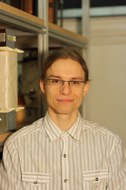Studien-, Diplom- und Masterarbeiten
Der prinzipielle Ablauf einer Studien- oder Diplomarbeit (SA/DA) an der Professur gliedert sich inhaltlich und zeitlich in folgende Schritte:
- Vorgespräch mit der betreuenden Person zum gegenseitigen Kennenlernen und Vorstellen der Aufgabenthematik.
- Formulierung der Aufgabenstellung durch die Professur und verbindliche Vereinbarung des Abgabetermin auf Basis der jeweils geltenden Prüfungsordnung – Regelbearbeitungszeit. Im Falle des Kürzels SA/DA wird der Umfang der Arbeit an angepasst.
- Einarbeitung in die Thematik anhand einer Literaturrecherche und der Unterstützung durch die betreuende Person.
- Aufstellen eines Zeitplans, um die gestellte Aufgabe im vorgegebenen Zeitraum zu bearbeiten (z.B. Gantt-Chart)
- Durchführen der geplanten Versuche, Modellbildungen, Berechnungen, o.ä.
- Schriftliche Dokumentation der Arbeit
- Präsentation der Ergebnisse in einer Verteidigung (für Studienarbeiten RES optional)
Abhängig von der Themenwahl und Ihren persönlichen Interessen erhalten Sie die Möglichkeit, Ihr Fachwissen indiviuell mit theoretischen oder praktischen Kenntnissen zu vertiefen.
Die inhaltliche und zeitliche Strukturierung der Studien- bzw. Diplomarbeit wird Sie optimal für die selbstständige Bearbeitung und Lösung von ingenieurtechnischen Problemstellungen vorbereiten.
Hochspannungstechnik
Wenn Sie an weiteren Themen für eine Studien- oder Diplomarbeit in diesem Bereich interessiert sind, sprechen Sie bitte Thomas Linde an.
 © Thomas Linde
© Thomas Linde
Dr.-Ing. Thomas Linde
Leiter der Forschungsgruppe Hochspannungstechnik
Eine verschlüsselte E-Mail über das SecureMail-Portal versenden (nur für TUD-externe Personen).
Professur für Komponenten Intelligenter Energienetze
Besuchsadresse:
Binder-Bau, TOE 116 Mommsenstraße 10
01069 Dresden
Wenn Sie an weiteren Themen für eine Studien- oder Diplomarbeit in diesem Bereich interessiert sind, sprechen Sie bitte Dipl.-Ing. Thomas Linde an.
Strombelastbarkeit und Erwärmung
Wenn Sie an weiteren Themen für eine Studien- oder Diplomarbeit in diesem Bereich interessiert sind, sprechen Sie bitte Dr. Robert Adam an.
 © Stephan Schlegel
© Stephan Schlegel
Dr.-Ing. Robert Adam
Leiter der Forschungsgruppe Strombelastbarkeit und Erwärmung
Eine verschlüsselte E-Mail über das SecureMail-Portal versenden (nur für TUD-externe Personen).
Professur für Komponenten Intelligenter Energienetze
Besuchsadresse:
Binder-Bau, BIN 120 Mommsenstraße 10
01069 Dresden
Wenn Sie an weiteren Themen für eine Studien- oder Diplomarbeit in diesem Bereich interessiert sind, sprechen Sie bitte Dr.-Ing. Robert Adam an.
Elektrische Kontakte und Verbindungen
| SA |
Mit der Elektromobilität wird eine verstärkte Nutzung elektrisch angetriebener Fahrzeuge im Individualverkehr angestrebt. Dabei führt die Elektrifizierung des Antriebs zu neuen Anforderungen an die verwendeten Fügeverfahren für stromführende Leiter, wenn diese sicher und langzeitstabil elektrische Ströme führen sollen. Ein in der Automobilbranche eingesetztes umformendes Fügeverfahren ist das Clinchen. In vorangegangenen Langzeituntersuchungen wurden das Kontaktverhalten von Clinchverbindungen stets mit dem Verbindungswiderstand oder dem Gütefaktor bewertet. Um das Kontaktverhalten dieser Verbindungen detaillierter bewerten zu können, ist es erforderlich, die Anteile des Material- und des Kontaktwiderstandes am Verbindungswiderstand in FEM-Modellen zu berechnen. Mit diesen Widerstandsanteilen soll anschließend in Parameterstudien der Einfluss verschiedener geometrischer Kenngrößen von Clinchverbindungen auf das elektrische Kontaktverhalten bewertet werden. |
| Beginn der Arbeit | ab sofort |
Betreuer
 © Markus Schladitz
© Markus Schladitz
Dipl.-Ing. Max Huter
Mitarbeiter Forschungsgruppe Elektr. Kontakte und Verbindungen
Eine verschlüsselte E-Mail über das SecureMail-Portal versenden (nur für TUD-externe Personen).
Professur für Komponenten Intelligenter Energienetze
Besuchsadresse:
Binder-Bau, BIN 122a Mommsenstraße 10
01069 Dresden
| DA | Die Belastungen, die auf eine elektrische Verbindung wirken, sind vielfältig. Bisher untersuchten Finite-Elemente-Simulationen, aus denen sich Aussagen zum Kontaktverhalten ableiten lassen, üblicherweise nur die Mechanik oder das elektrische oder thermische Strömungsfeld oder eine Koppelung von zwei dieser Größen. Tatsächlich beeinflussen sich aber Verbindungskraft, Verbindungswiderstand und Verbindungstemperatur gegenseitig. In dieser Arbeit soll mithilfe moderner FE-Software die Wechselwirkung von Mechanik und elektrischen und thermischen Strömungssfeld in einem Modellkontaktsystem untersucht werden. |
| Beginn der Arbeit | ab sofort |
Betreuer
 © Stephan Schlegel
© Stephan Schlegel
Dr.-Ing. Christian Hildmann
Leiter der Forschungsgruppe Elektr. Kontakte und Verbindungen
Eine verschlüsselte E-Mail über das SecureMail-Portal versenden (nur für TUD-externe Personen).
Professur für Komponenten Intelligenter Energienetze
Besuchsadresse:
Binder-Bau, BIN 122c Mommsenstraße 10
01069 Dresden
| DA/SA | Die Ansteuerung von Versuchstechnik für Hochstromversuche und die der verwendeten Temperatur- und Widerstandsmesstechnik sind zu verknüpfen und an einem stromdurchflossenen Langzeitversuch experimentell zu erproben. |
| Beginn der Arbeit | ab sofort |
Betreuer
 © Stephan Schlegel
© Stephan Schlegel
Dr.-Ing. Christian Hildmann
Leiter der Forschungsgruppe Elektr. Kontakte und Verbindungen
Eine verschlüsselte E-Mail über das SecureMail-Portal versenden (nur für TUD-externe Personen).
Professur für Komponenten Intelligenter Energienetze
Besuchsadresse:
Binder-Bau, BIN 122c Mommsenstraße 10
01069 Dresden
| DA/SA |
Hohe Kurzzeitströme erwärmen stromführenden Verbindungen mit Flächenkontakten in der Regel nicht stärker als den angeschlossenen Leiter. Zusätzlich kann abhängig aber von der Stromstärke eine nicht zu vernachlässigende Erwärmung der Mikrokontakte erfolgen. Zielstellung der Arbeit ist, das elektrisch-thermische Verhalten stromführender Verbindungen bei Belastung mit Kurzschlussstrom zu untersuchen und mit einfachen Abschätzungen der Kontakttemperatur zu korrelieren. |
| Beginn der Arbeit | ab sofort |
Betreuer
 © Stephan Schlegel
© Stephan Schlegel
Dr.-Ing. Christian Hildmann
Leiter der Forschungsgruppe Elektr. Kontakte und Verbindungen
Eine verschlüsselte E-Mail über das SecureMail-Portal versenden (nur für TUD-externe Personen).
Professur für Komponenten Intelligenter Energienetze
Besuchsadresse:
Binder-Bau, BIN 122c Mommsenstraße 10
01069 Dresden
| DA/SA | In zahlreichen Untersuchungen wurde der Kraftabbau an Schraubenverbindungen mit Stromschienen mit dem Verlauf der Verbindungskraft bewertet. Über den Verlauf der mittleren mechanischen Spannung in der Trennfuge soll eine erneute Bewertung der bestehender und aktueller Versuchsergebnisse erfolgen. |
| Beginn der Arbeit | ab sofort |
Betreuer
 © Anne Oehlert
© Anne Oehlert
PD Dr.-Ing. habil. Stephan Schlegel
Leiter des Fachbereichs Hochstromtechnik
Eine verschlüsselte E-Mail über das SecureMail-Portal versenden (nur für TUD-externe Personen).
Professur für Komponenten Intelligenter Energienetze
Besuchsadresse:
Binder-Bau, BIN 122c Mommsenstraße 10
01069 Dresden
Wenn Sie an weiteren Themen für eine Studien- oder Diplomarbeit in diesem Bereich interessiert sind, sprechen Sie bitte Dr.-Ing. Christian Hildmann an.
Abgeschlossene Abschlussarbeiten
Im unten angeführten Link erhalten Sie einen Überblick über bereits abgeschlossene Arbeiten an unserer Professur.
